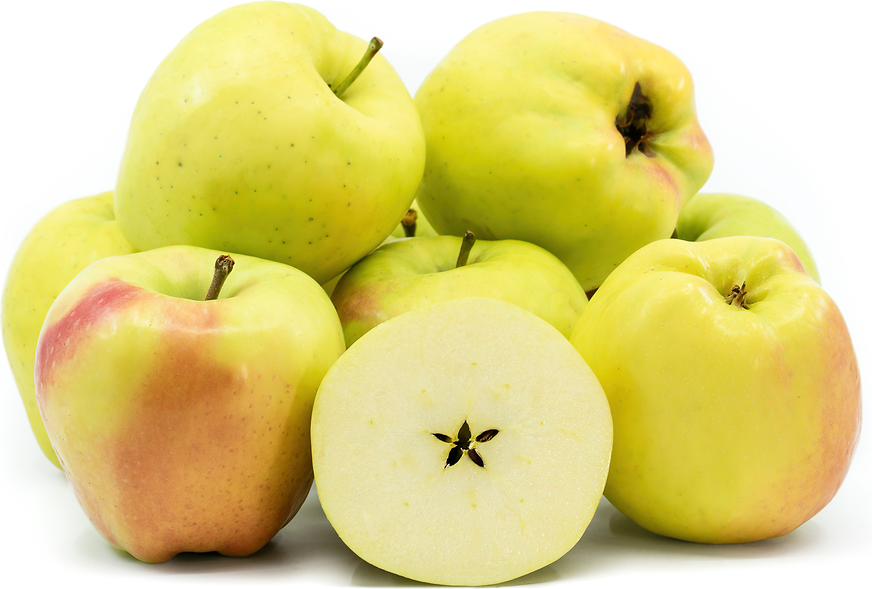


Candy Crisp® Apples
Estimated Inventory, lb : 0
Description/Taste
Candy Crisp® apples are a medium to large varietal, averaging 8 to 9 centimeters in diameter and 292 grams in weight, and have a round to conical shape with a blocky, tapered appearance. The variety is known for having a shape reminiscent of Red Delicious apples, one of its parent varieties, and has broad, square ribbed shoulders and a narrow base featuring distinct points around the calyx. The stem is generally slender, woody, and fibrous, ranging from green to brown, and there is a light russeting sometimes found within the stem cavity. The apple’s skin is moderately thick, smooth, and taut with a rubbery feel. The surface is also covered in small indentations and bumps, giving the skin a textured nature. Candy Crisp® apples ripen from green to yellow-green or solid yellow, and depending on sun exposure during cultivation, the fruits develop patches of pink, red, and orange blush. This blush can be faint or saturated, and the surface is covered in prominent lenticels. Underneath the skin, Candy Crisp® apples have a pale yellow to ivory flesh and are semi-coarse, firm, and aqueous with a crisp and crunchy consistency. The flesh also encases a small central core filled with tiny, black-brown seeds. Candy Crisp® apples are edible raw and are high in sugar, reaching 17 to 18 degrees Brix, and low in acidity, creating a sweet, sugary, and mild taste. The variety also has a distinct pear-like flavor and is said to be more pear-like than apple-like in taste.
Seasons/Availability
Candy Crisp® apples are harvested in the late fall through early winter and can be stored through the early spring.
Current Facts
Candy Crisp® apples, botanically classified as Malus domestica, are an American variety belonging to the Rosaceae family. The late-season apples were discovered as a chance seedling in an orchard in New York state in the early 21st century and were selected as a new variety for their large size, crunchy flesh, and sweet taste. Candy Crisp® apples are thought to be a descendant of Red Delicious apples and share similar physical characteristics, including their square, blocky shoulders, tapered nature, and pointed base. Growers favor Candy Crisp® apple trees for their ability to grow fruit 2 to 5 years after planting and vigorous, productive nature. The trees produce high yields of cold-hardy, disease-resistant apples, and the variety can be planted in semi-dwarf or dwarf sizes for ease of cultivation. Candy Crisp® apples are also known as GRE-1198 and received their candy-focused brand name in honor of their sugary-sweet taste and crisp nature. In the modern day, Candy Crisp® apples are not well-known across the United States, but they are increasing as a small-scale commercial variety grown as a multi-purpose, fresh eating and cooking apple.
Nutritional Value
Candy Crisp® apples have not been extensively studied for their nutritional properties. Like other commercial fruits, the variety is a source of vitamin C to boost the immune system, fiber to regulate the digestive tract, potassium to balance fluid levels within the body, and vitamin A to maintain healthy organ functioning. The variety also provides vitamin E to reduce inflammation, vitamin K to assist in generating bone tissue, calcium to build strong teeth and bones, and other nutrients such as magnesium, boron, copper, iron, zinc, and phosphorus.
Applications
Candy Crisp® apples have a mild and sweet taste suited for fresh and cooked preparations. Depending on preference, the variety can be consumed straight out of hand and eaten with or without the skin. Candy Crisp® apples can also be sliced and dipped in nut butter to add savory notes as a snack, chopped and tossed into salads, or layered into parfaits. Try blending the variety with citrus or other tangy ingredients in juices and smoothies. The apples can also be used in ciders with other more robust flavored apples. In addition to fresh preparations, Candy Crisp® apples are occasionally utilized in applesauce or simmered into jams, jellies, compotes, and other preserves. The variety needs to be paired with more sour apples, such as Granny Smith, in baking, but it can add sweet notes to cakes, muffins, pies, crisps, and cobblers. While less common, Candy Crisp® apples can be sliced and dried into rings for extended use. Candy Crisp® apples pair well with nuts such as almonds, pistachios, walnuts, and pine, cheeses including cheddar, brie, feta, goat, and blue, or fresh herbs such as cilantro, mint, or parsley. Whole, unwashed Candy Crisp® apples will last up to four months when stored in a cool, dry, dark place such as a cellar or refrigerator’s crisper drawer.
Geography/History
Candy Crisp® apples are native to New York and were discovered in an orchard near Marlboro in the Hudson Valley in New York State. Mark Greiner is credited with finding the variety growing as a chance seedling in a Red Delicious orchard. The parentage of Candy Crisp® apples is unknown, but pomologists believe Red Delicious is one of the parents. After noticing the chance seedling, Greiner began propagating the fruits onto existing trees in the orchard, naming the new variety GRE-1198. The variety was commercially released in 2005, and a patent was filed in March 2005 and granted in December 2006 under United States Plant Patent #17284. The patent is active until 2025. In commercial markets, GRE-1198 was renamed Candy Crisp® to increase consumer appeal. Today, Candy Crisp® apples are seasonally sold through select growers, distributors, and fresh markets in the United States.
Recipe Ideas
Recipes that include Candy Crisp® Apples. One
| Fine Cooking |
|
Homemade Apple Cider |




